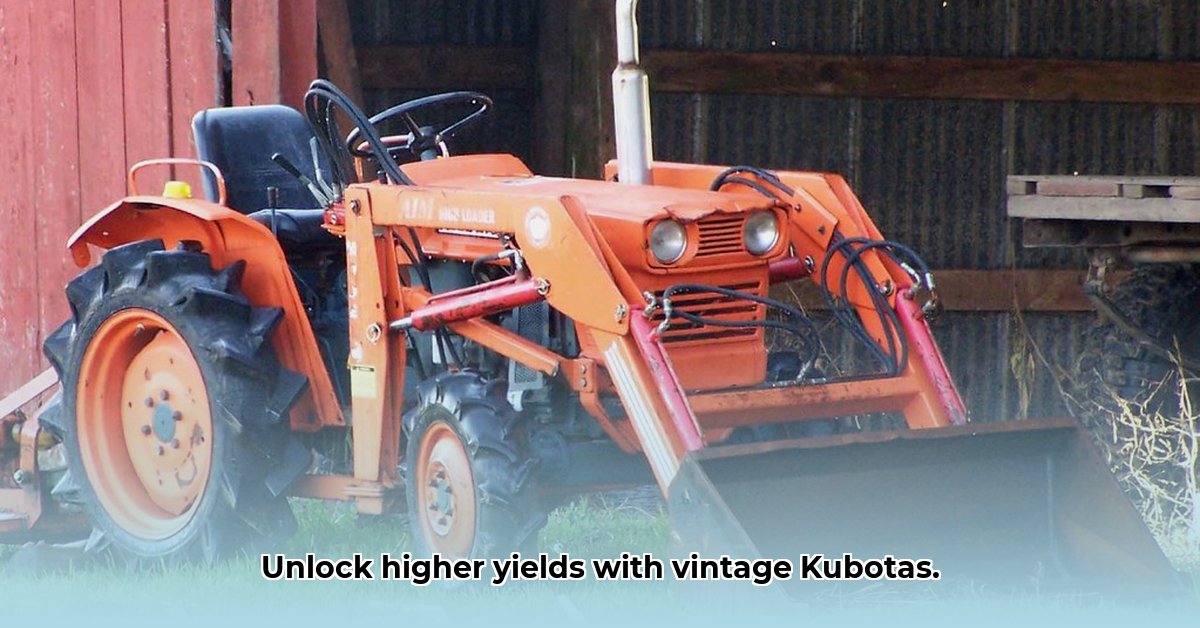
Old Kubota tractors are more than just vintage machinery; they're reliable workhorses ideally suited for sustainable farming practices. Their robust build and simple design offer both dependability and a lower environmental impact compared to modern counterparts. This guide will help you maintain, repair, and efficiently operate your old Kubota, maximizing its lifespan and minimizing your environmental footprint. We'll also share inspiring stories from farmers successfully using these tractors in sustainable farming operations. For more information on specific models, check out this helpful resource on older Kubota models.
Keeping Your Old Kubota in Tip-Top Shape: Essential Maintenance
Regular maintenance is key to maximizing your Kubota's efficiency, minimizing fuel consumption, and extending its lifespan. Think of it as investing in a long-term partnership.
Oil Changes: The Life Blood of Your Tractor: Change your oil more frequently than recommended – every 25-50 hours, depending on workload and oil condition. Using the correct oil grade (check your owner's manual) prevents costly engine repairs. Isn't preventing costly repairs worth the extra effort?
Fluid Checks: Staying on Top of Essentials: Regularly check coolant, transmission fluid, and hydraulic fluid levels. Low levels can lead to major problems. Make this a pre-operation routine. A quick check can save hours of downtime.
Filters: Your Engine's Best Friends: Regularly replace air, fuel, and oil filters. A clogged filter restricts airflow and fuel delivery, impacting performance. Preventative maintenance is always cheaper than repairs.
Belt Inspection: Keeping Things Running Smoothly: Regularly inspect belts for cracking, fraying, or glazing. Replace worn belts. A broken belt can halt your entire operation.
Tire Pressure: A Simple Step, Big Rewards: Maintaining correct tire pressure (check your owner's manual) minimizes rolling resistance, improving fuel efficiency and tire life. Proper tire pressure can significantly lower fuel costs.
Finding the Right Parts: Sourcing for Your Old Kubota
Finding parts for older Kubotas isn't as challenging as you might think.
Online Marketplaces: Many online marketplaces specialize in parts for vintage tractors. Utilize their vast catalogs and user reviews to find what you need.
Local Dealers: Contact Kubota or agricultural equipment dealerships; they might still carry parts for older models, especially in rural areas.
Salvage Yards: Salvage yards are great for affordable used parts, especially for less critical components. You might unearth hidden treasures!
Fuel Efficiency and Longevity: Sustainable Operation Strategies
Operating your Kubota efficiently extends its life and minimizes your environmental impact.
Gentle Warm-up: Allow your tractor to warm up gently before heavy loads to reduce wear and tear. A few minutes of idling protects your engine.
Avoid Overloading: Never exceed your tractor's designed capabilities. Overloading strains components and leads to costly repairs. Work smarter, not harder!
Fuel Efficiency: Maintain optimal tire pressure and avoid unnecessary idling to reduce fuel consumption. Every drop saved benefits your wallet and the environment.
Regular Inspections: Conduct a quick visual inspection before each use to catch minor problems before they become major breakdowns.
Troubleshooting Common Issues: Quick Fixes and Solutions
Even with regular maintenance, problems can occur.
| Problem | Possible Cause(s) | Suggested Solutions |
|---|---|---|
| Engine Won't Start | Dead battery, faulty starter, fuel system problems | Check battery voltage, inspect starter motor, check fuel lines and filter |
| Loss of Power | Low oil pressure, clogged air filter, fuel starvation | Check oil level, replace air filter, inspect fuel system |
| Hydraulic Problems | Low hydraulic fluid, leaks, worn pump components | Check fluid level, inspect hoses for leaks, consider professional repair |
| Unusual Noises | Worn bearings, loose bolts, worn gears | Inspect bearings, tighten bolts, check gears for damage |
Real-Life Success Stories: Farmers and Their Kubotas
"My old Kubota has been my partner for over 20 years," says Maria Hernandez, owner of Green Valley Farm. "With proper maintenance, it's still going strong, helping me produce high-quality, sustainable crops." These stories highlight the resilience, reliability, and cost-effectiveness of older Kubotas in sustainable farming.
Calculating the Economic Viability of Regenerative Farming with Old Kubotas
Regenerative farming, while environmentally beneficial, demands careful financial planning. Used Kubotas significantly reduce initial equipment costs.
Key Steps:
Assess Resources: Consider land ownership, existing tools, and the condition of your Kubota.
Estimate Costs: Include land costs, equipment (including repairs), inputs (seeds, fertilizers), labor, marketing, and certifications.
Project Income: Estimate yields (accounting for potential increases), pricing strategies, and any value-added products.
Analyze Profitability: Subtract total costs from total revenue to determine profitability over several years. Remember, long-term soil health usually increases yields.
Maximize Efficiency: Regular maintenance, fuel efficiency techniques, and smart parts sourcing are crucial for maximizing your Kubota's lifespan and minimizing running costs.
Remember, responsible ownership of your old Kubota isn't just cost-effective; it's a contribution to a more sustainable future for agriculture. By following these guidelines, you can keep your Kubota running efficiently and contribute to a thriving, sustainable farm.